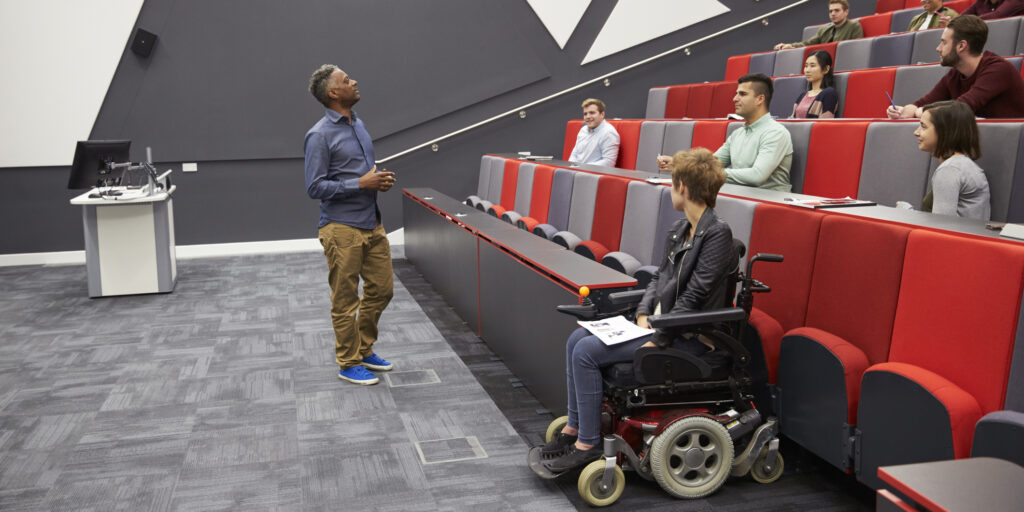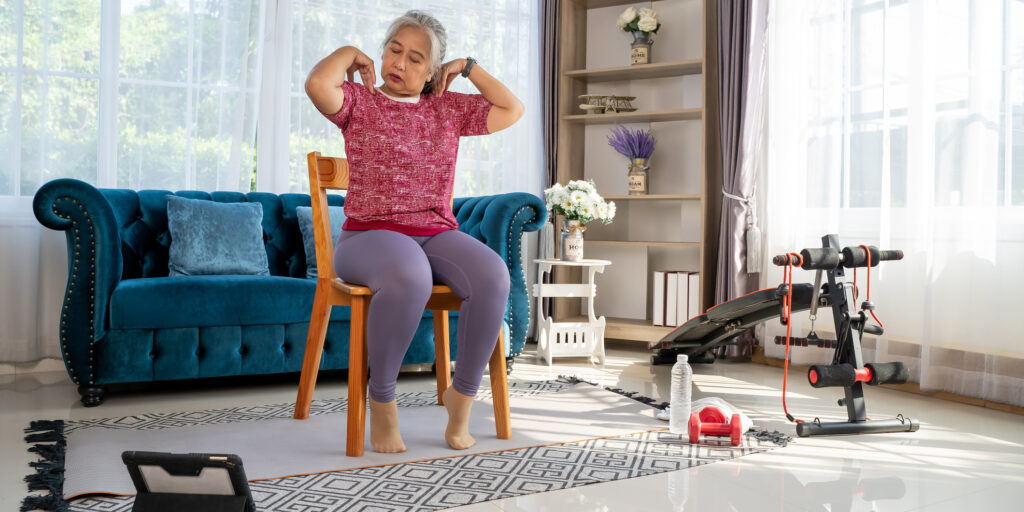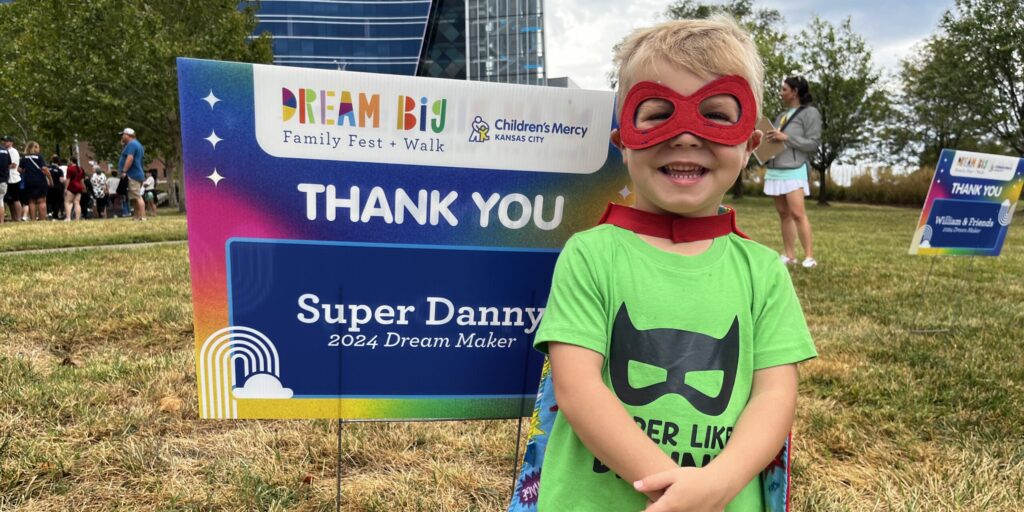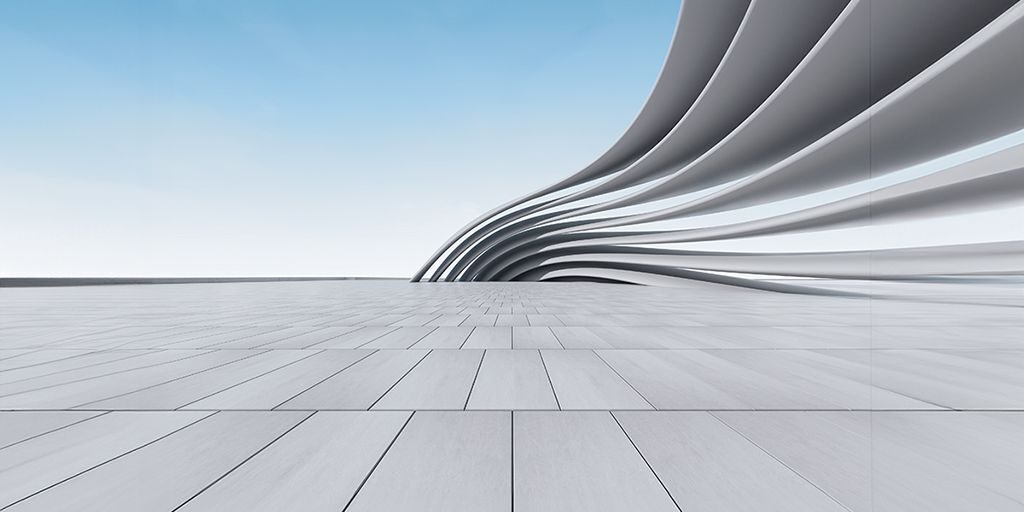
Building With Universal Design Is Good for Everyone
By Matt Alderton | Friday, May 10, 2024
5 Second Summary
Can architecture affect your health? It can when the built environment around you limits your ability to fully participate in public life. Learn how universal design creates spaces that bring people of all abilities together, and how to find accessible places.
The Mizzou Arena in Columbia, Missouri, is home court for the University of Missouri (MU) men’s and women’s basketball teams and serves as an entertainment venue in the off-season.
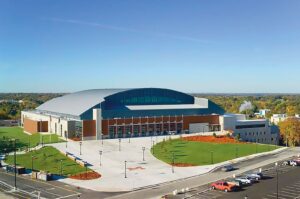
The Mizzou Arena has a large, sloping promenade leading to the entrance doors, rather than stairs.
The architects who designed the arena, which opened in 2004, knew that the entrance was important — it would welcome throngs of fans of all ages. They initially designed a showcase entrance plaza with flights of stairs with intermediate landings across the arena’s width. They ensured it was accessible by placing ramps at the far left and right sides.
Fortunately, Richard Sternadori, Senior Program Coordinator, Researcher, and Director of the Accessible Design Accreditation Initiative for the University of Missouri (MU) Department of Architectural Studies Great Plains ADA Center, was a consultant on the project.
“When the initial drawings came to my office, we suggested a gentle slope from the curb all the way to the multiple entrances,” Richard says. The result is a large, open concrete promenade that eases the flow of crowds toward the entrance doors and allows families and groups of friends to stay together, whether they are on foot, in wheelchairs, using walkers, or pushing strollers. The effect is more welcoming and no less grand.
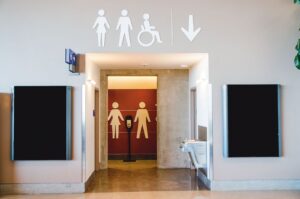
A winding hallway entrance blocks visibility into these restrooms. This doorless design increases accessibility and reduces the spread of disease by eliminating high-touch surfaces.
This is an example of universal design, which the Center for Inclusive Design and Environmental Access (IDEA Center) at the University of Buffalo’s School of Architecture and Planning defines as “a design process that enables and empowers a diverse population by improving human performance, health and wellness, and social participation.”
Increasingly, architects who design everything from office buildings and outlet malls to retail stores and stadiums are recognizing the merits of designing buildings and spaces that are equitable, accessible, and enjoyable for everyone, regardless of age, background, or ability.
What is universal design?
Architect Jonathan White, Director of Design Consulting at the IDEA Center, describes it in even simpler terms: “Universal design makes life easier, healthier, and friendlier for everyone,” he says. “It’s not just about accommodating people with disabilities, although that’s certainly a prerequisite. It’s about making the environment usable for everyone, whether that’s parents with small children, older adults, people from different socioeconomic backgrounds, or people from different cultures — whatever the case may be.”
Universal design goals
The IDEA Center operates according to eight goals for universal design:
- Body fit: Accommodating a wide range of body sizes and abilities
- Comfort: Keeping demands within desirable limits of body function and perception
- Awareness: Ensuring that critical information for use is easily perceived
- Understanding: Making methods of operation and use intuitive, clear, and unambiguous
- Wellness: Contributing to health promotion, avoidance of disease, and protection from hazards
- Social integration: Treating all groups with dignity and respect.
- Personalization: Incorporating opportunities for choice and the expression of individual preferences
- Cultural appropriateness: Respecting and reinforcing cultural values and the social and environmental contexts of any design project
Universal design and accessibility
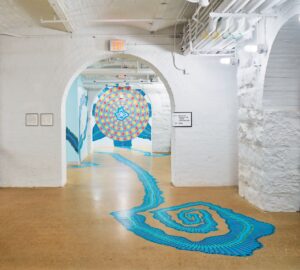
At the MuseumLab, murals assist with wayfinding, indicating paths from one space to another.
When architect Ron Mace first coined the term “universal design” in 1985, he was reacting to building codes and regulations that he saw as encumbering accessibility rather than enhancing it. For example, the Americans with Disabilities Act (ADA) requires developers to design buildings and public spaces in ways that accommodate people with disabilities. In practice, however, it sometimes constrains accessibility by putting an unintended ceiling on it.
“Often, the regulatory approach is perfunctory. People want to know, ‘What’s the minimum I can do? What can I get away with?’” Richard says. “Universal design is better in that respect because it doesn’t take that minimalist approach to design. It takes a broader approach.”
Because that broader approach isn’t focused on ADA compliance, Richard stresses that universal design is not a substitute for accessible design. Rather, the two are complementary. “If it’s done right, universal design serves everyone. That’s the intent,” he says. “Universal design and accessible design should work hand-in-hand.”
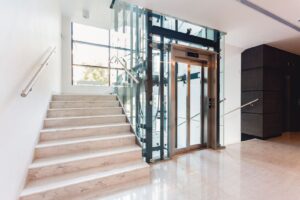
Keeping the elevator and stairs adjacent allows people with different abilities, such as wheelchair users and their colleagues or caregivers, to stay together as they navigate a building.
When they do, the results can be transformational for individuals as well as communities, according to architect Erin Peavey, Vice President and Health and Well-being Design Leader at Dallas-based architecture firm HKS. “Social connection is critical to all of life thriving,” says Erin, who points out that scientists have linked social connectedness to increased health, happiness, and longevity.
In fact, the more isolated someone is, the more likely they are to experience heart disease and stroke, type 2 diabetes, depression and anxiety, addiction, dementia, and early death, the Centers for Disease Control and Prevention (CDC) reports. “And yet, the built environments we’re creating regularly make it so that people are left out with no real option to be included,” Erin says.
Universal design examples
What does universal design mean in real life? Consider something as simple as a sidewalk with a ramp to the street. “Curb cuts are something that for the longest time we didn’t have, but they are helpful for everyone,” explains Erin. They make navigating sidewalks easier not only for wheelchair users but also for seniors with walkers, injured people on crutches, parents pushing strollers, and travelers pulling luggage.
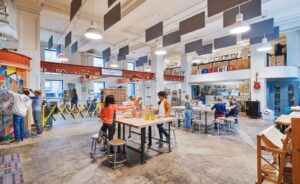
In the Make Lab at MuseumLab, workstations are spaced far apart to allow easy movement around them.
Applying universal design to a pedestrian crosswalk might go several steps further than curb cuts and add visible crossing warnings and protective posts. “Another approach is to raise the crossing to the sidewalk level — make the cars navigate the hill instead of the people,” Jonathan says. “This also helps drain water away from the crossing instead of allowing a puddle to accumulate.”
Or consider a playground. “I have a 5-year-old daughter, and when we go to parks there are a lot of things that are not inclusive,” Erin says. Many playgrounds have a loose ground cover, such as wood chips, that is difficult to navigate with limited mobility. A better choice is poured-in-place rubber, which makes playgrounds accessible to all children, as well as their parents and grandparents.
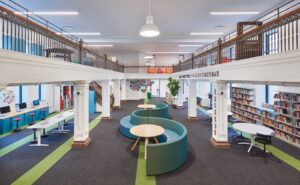
A classroom space at the MuseumLab incorporates diverse seating options.
“If I were to design a playground, I might make sure there’s a fence with an entrance that can be monitored, and a shelter with seating and bathrooms, so adults can stay there comfortably all day and watch their kids,” adds Jonathan, who says universal design is as much about comfort and safety as it is about accessibility.
Jonathan’s favorite example of universal design is the MuseumLab at the Children’s Museum of Pittsburgh, a hands-on space for kids to experiment with art and technology. Opened in 2019 in a renovated historic building, it features spacious elevators and bathrooms with room for wheelchairs to turn around, large gaps between workstations to accommodate kids with mobility devices, lobbies and hallways with generous circulation paths for family groups and strollers, and easy-to-see directional signage at every turn.
Be a champion for change
For a variety of reasons — budget constraints, lack of awareness among architects and developers, and perceived complexity, just to name a few — universal design is not yet practiced universally. Fortunately, there are things you can do to champion universal design in your community.
It starts with future architects, according to Richard, who recommends supporting the Accessible Design Accreditation Initiative, which he directs. The initiative’s goal is to update architecture and interior design curriculums at colleges and universities to include the latest accessible design standards. Supporters can add their names to a list of co-sponsors online, or they can express their support directly to any of the four national accreditation organizations that assess and validate design programs at universities. The MU Great Plains ADA Center offers more information here.
“If we can get schools to take this seriously — to make sure students graduate understanding how important accessible design is to their clients, to the firms that hire them, to people with disabilities, and to society in general — then we’ve changed the world and America,” Richard says.
At the local level, find out if your town or city government has an accessibility board, council, or commission, suggests Erin, who says citizens can often join or advise such groups to raise awareness about universal design tenets and opportunities. Also, look for meetings about proposed building projects and open comment periods when developers solicit public feedback.
Jonathan adds that it can be especially persuasive when you make a business case for universal design. “There’s a supermarket chain in Germany called Kaiser’s. They implemented a bunch of universal design strategies throughout their stores and saw a 30% increase in revenues,” he notes.
The key for everyone — designers, developers, policymakers, and citizens — is education. “If you educate yourself and use your knowledge to educate others, that’s what will create change in your community,” Jonathan says.
Matt Alderton is a Chicago-based freelance writer who frequently covers health topics.
3 Ways to Find Accessible Places
Use these tools to find accessible spaces in your community or when you visit a new place:
Google Maps: The “Accessible places” feature is available on a phone, tablet, or computer. In the app, tap your profile picture or initials, then tap “Settings” and “Accessibility.” From there, turn on “Accessible places.” With this feature on, wheelchair icons on the map indicate wheelchair-accessible businesses and other places of interest.
AccessNow: This app connects you to a global community of citizen mappers who identify accessible places — like hotels, restaurants, restrooms, and parks — based on firsthand experience. You can search for places with specific accessibility features and contribute to the AccessNow community by ranking and reviewing places you visit.
Ahoi: To use this app, create a profile with your specific accessibility needs, such as entry ramps or automatic doors. Then, you can find destinations, from retail stores to doctor’s offices, ranked by how well they meet your needs, with community-driven reviews that include photos. The app also uses wayfinding technology and sidewalk health data to help you navigate safely to your destination.
Next Steps and Useful Resources
- Listen to a conversation with Dominic Marinelli, a certified Accessibility Specialist/Plans Examiner, about making buildings more accessible.
- Learn how you can make a difference by becoming an MDA advocate.
- Stay up-to-date on Quest content! Subscribe to Quest Magazine and Newsletter.
TAGS: Community, Featured Content
TYPE: Featured Article
Disclaimer: No content on this site should ever be used as a substitute for direct medical advice from your doctor or other qualified clinician.


